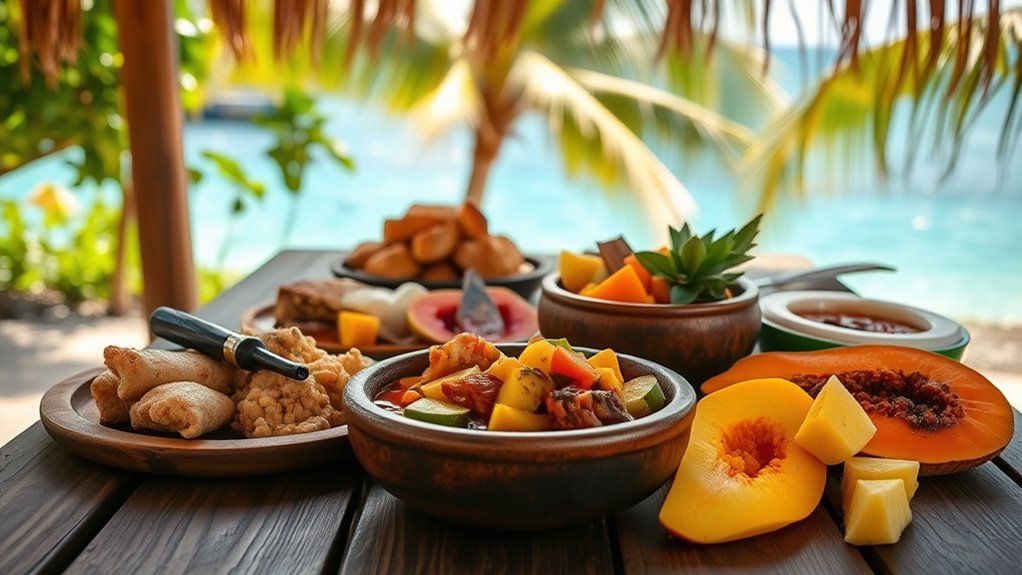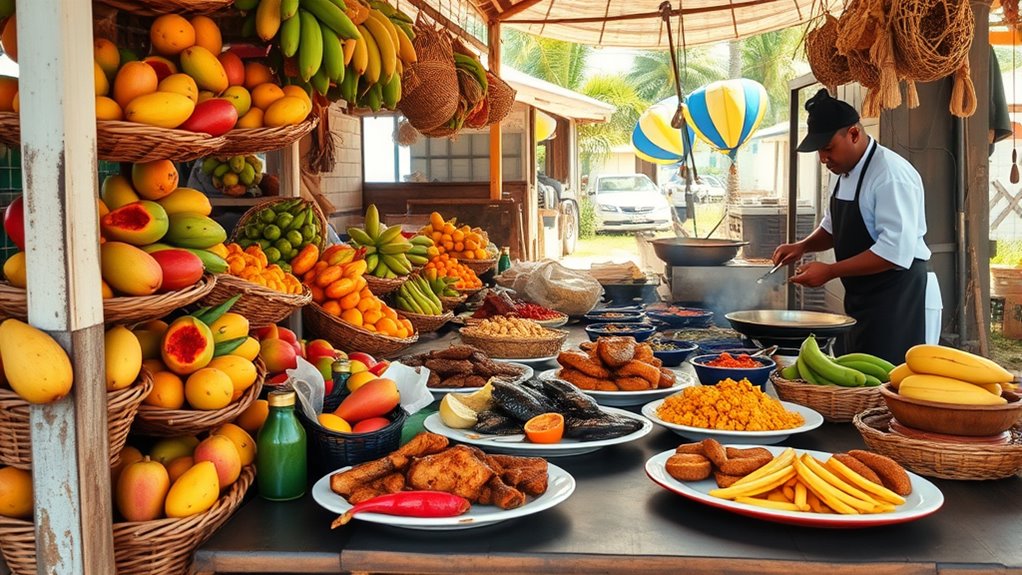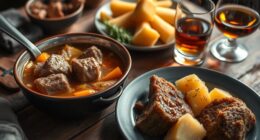Explore the vibrant cuisine of the U.S. Virgin Islands, where African, European, and indigenous influences blend to create hearty, flavorful dishes. You’ll find traditional staples like fish and fungi, callaloo, Johnny Cake, and roti, all crafted with fresh local ingredients like seafood, breadfruit, and herbs. Food plays a key role in community celebrations and preserving culture. Keep exploring to discover how tradition and innovation shape the islands’ unique culinary scene.
Key Takeaways
- Virgin Islands cuisine is shaped by African, European, and indigenous influences, emphasizing hearty, portable foods like fish, fungi, and callaloo.
- Traditional dishes such as Johnny Cake, Pate, and Roti reflect cultural heritage and culinary ingenuity.
- Local ingredients like fresh seafood, plantains, and breadfruit are central, often prepared through frying, stewing, or grilling.
- Food plays a vital role in community celebrations, preserving cultural identity through shared meals and festivals.
- Modern trends include fusion cuisine, farm-to-table practices, and innovative presentation, blending tradition with contemporary influences.
Historical Influences on Virgin Islands Cuisine

The cuisine of the U.S. Virgin Islands reflects a complex history shaped by various influences. You’ll notice the impact of slavery, which introduced dishes like fish and fungi, born from limited rations of salted fish and cornmeal. The islands’ diverse heritage blends African, European, and indigenous traditions, creating a rich culinary tapestry. Necessity drove the development of portable, hearty foods that could sustain workers, leading to dishes designed for on-the-go eating. Despite Danish rule, their cuisine didn’t markedly alter local flavors, as climate and ingredients differed. Over time, local ingredients and spices have been integrated, enriching traditional recipes. This history of resilience and adaptation continues to influence the vibrant food scene, keeping cultural roots alive through every bite. Relationship aspects of cultural exchange also played a significant role in shaping regional flavors and cooking techniques, fostering a sense of community and shared identity.
Traditional Dishes and Their Cultural Roots

Traditional dishes of the U.S. Virgin Islands reflect a rich blend of African, European, and indigenous influences. You’ll notice dishes like fish and fungi, which originated from salted fish and cornmeal rations during slavery, symbolizing resilience and resourcefulness. Callaloo, made from dasheen leaves, represents the importance of local ingredients and communal cooking. Johnny Cake, a simple fried or baked cornmeal bread, is a staple for breakfast and snacks, showcasing Caribbean flavors. Roti, with Indian roots, highlights the islands’ diverse cultural connections, while Pate, a fried pastry filled with meat or seafood, reveals culinary ingenuity. These dishes aren’t just food; they embody history, survival, and community, passing down stories and traditions from generation to generation. Their roots illustrate the islands’ complex cultural tapestry, and understanding cultural influences can deepen appreciation for these traditional recipes.
The Role of Food in Community and Celebrations

Food brings people together in the U.S. Virgin Islands, especially during community events and celebrations. Sharing traditional dishes strengthens bonds and keeps cultural stories alive. How do these culinary moments shape the islands’ sense of identity and unity? Incorporating targeted campaigns and personalized communication can further enhance community engagement around these shared food traditions.
Food as Cultural Bond
In the U.S. Virgin Islands, food acts as a powerful cultural bond that unites communities. When you share a meal, you’re participating in a tradition that links generations and preserves heritage. Family recipes are handed down, maintaining cultural identity amid changing times. During local festivals, street foods and communal dishes bring people together, fostering a sense of belonging. Food also marks important milestones like weddings, religious celebrations, and holidays, strengthening social ties. By gathering around traditional dishes like fish and fungi or callaloo, you connect with the islands’ history and diverse influences. Sharing these meals helps keep cultural stories alive, creating a collective memory. Additionally, traditional foods often incorporate essential oils that have been used historically for their health benefits, further enriching the cultural significance of these dishes. Food becomes more than sustenance; it’s a symbol of community resilience and cultural continuity.
Celebratory Culinary Traditions
Celebratory events in the U.S. Virgin Islands revolve around food, bringing communities together to honor traditions and history. During festivals, you’ll find an abundance of street foods like pate, Johnny cakes, and callaloo, shared among friends and family. These gatherings often feature communal feasts, where everyone contributes dishes passed down through generations. Food plays a crucial role in marking special occasions such as Carnival, Emancipation Day, and religious celebrations, reinforcing cultural identity and unity. Traditional recipes are prepared with local ingredients, emphasizing flavors that reflect the islands’ diverse heritage. Sharing meals during these events strengthens bonds and keeps cultural stories alive. Recognizing the importance of cultural identity helps explain how shared culinary traditions foster community resilience and continuity. Whether at lively festivals or intimate family gatherings, food remains central to celebrating community, history, and resilience in the U.S. Virgin Islands.
Modern Trends Shaping the Culinary Scene

Modern trends are transforming the culinary scene in the U.S. Virgin Islands. You’ll notice a surge in fusion cuisine, blending traditional flavors with international influences to create innovative dishes. The farm-to-table movement is gaining momentum, emphasizing the use of locally sourced ingredients like breadfruit, plantains, and fresh seafood, which boosts the local economy and enhances authenticity. Upscale restaurants are putting gourmet twists on classic dishes, adding global spices and modern presentation. Sustainability challenges are prompting chefs and restaurateurs to explore eco-friendly practices, ensuring the future of local cuisine. Additionally, inventive dining experiences are emerging, with venues experimenting with traditional ingredients in new ways to surprise and delight diners. These trends reflect the islands’ dynamic culinary landscape and its ongoing evolution. Incorporating raw food diets and mindful eating principles, some establishments are even experimenting with raw or minimally processed ingredients to cater to health-conscious travelers.
Key Ingredients and Cooking Techniques

Key ingredients define the vibrant flavors of U.S. Virgin Islands cuisine. You’ll notice the importance of fresh, local elements that give dishes their unique taste. Here are four key ingredients and techniques:
- Seafood: Fresh fish and shellfish are staples, often grilled, stewed, or fried to highlight their natural flavors.
- Local herbs and spices: Scotch bonnet peppers, thyme, garlic, and ginger add heat and depth to dishes.
- Plantains and breadfruit: Used in frying, mashing, or baking, these starchy staples enrich many recipes.
- Traditional methods: Frying, stewing, and grilling are common techniques, preserving the authenticity of dishes like fish and fungi or Johnny cakes.
These ingredients and methods form the backbone of authentic Virgin Islands cooking.
Experiencing Virgin Islands Food Through Tours and Festivals

Exploring the culinary scene of the U.S. Virgin Islands, you’ll find vibrant food tours and lively festivals that bring local flavors to life. Food tours like the Taste of Twin City immerse you in the islands’ history and culture, guiding you through markets, street stalls, and family-run eateries. Here, you get to sample authentic dishes, learn about traditional ingredients, and hear stories from locals. Festivals such as the St. Thomas Carnival or Virgin Islands Food Festival showcase a wide array of street foods, music, and dance, creating a festive atmosphere. Participating in these events allows you to connect directly with the community, experience authentic flavors, and gain insight into the islands’ rich culinary heritage. These experiences make exploring Virgin Islands cuisine both immersive and memorable. Vetted – Textile Line
Fusion and Innovation in Contemporary Cuisine

Fusion and innovation are transforming the culinary landscape of the U.S. Virgin Islands. You’ll notice chefs blending traditional ingredients with global influences, creating exciting new flavors. Here are some key trends:
- Global Flavors – International spices and techniques, like Asian or Mediterranean, are infused into local dishes, giving them a modern twist.
- Gourmet Fusion – Upscale restaurants reinterpret classics like fish and fungi with techniques such as sous vide or molecular gastronomy.
- Local Sourcing – Chefs emphasize farm-to-table principles, using fresh, local ingredients to craft innovative dishes.
- Creative Presentations – Traditional dishes are plated artistically, combining vibrant colors and modern styles to appeal visually and gastronomically.
This blending of tradition and innovation keeps Virgin Islands cuisine vibrant, fresh, and relevant.
Preserving Heritage Through Culinary Practices

As chefs and communities embrace culinary innovation, they also recognize the importance of safeguarding traditional practices that define Virgin Islands cuisine. You can do this by passing down recipes through generations, ensuring that dishes like fish and fungi, callaloo, and Johnny Cake remain alive. Participating in local festivals and community gatherings helps keep these traditions vibrant, while sharing meals reinforces cultural bonds. You might also learn traditional cooking methods, such as stewing and frying, from seasoned elders or during culinary workshops. Supporting local markets and sourcing native ingredients like breadfruit, plantain, and fresh seafood guarantees authenticity. Additionally, implementing cost-effective production methods for traditional ingredients can help preserve these culinary practices by making them more accessible. By celebrating and practicing these customs regularly, you help preserve the unique culinary identity of the Virgin Islands for future generations.
Frequently Asked Questions
How Do Dietary Restrictions Influence Virgin Islands Traditional Dishes?
You’ll find that dietary restrictions influence Virgin Islands dishes by inspiring modifications or substitutions. For example, if you avoid salt, chefs may use herbs and spices like Scotch bonnet peppers to add flavor. Vegetarians might enjoy dishes like callaloo or fungi without meat, while those avoiding seafood can opt for plant-based options. These adaptations help preserve traditional flavors while respecting personal or cultural dietary needs.
What Role Do Local Herbs Play in Virgin Islands Beverages?
You’ll find that local herbs play a essential role in Virgin Islands beverages, adding unique flavors and aromatic qualities. You might use herbs like lemongrass, mint, or bush leaves to infuse drinks with crisp, natural tastes. These herbs not only enhance the flavor but also connect you to the islands’ cultural heritage. Incorporating them into your beverages creates a invigorating, authentic experience that celebrates the vibrant, diverse traditions of the Virgin Islands.
Are There Specific Cooking Techniques Unique to Virgin Islands Cuisine?
You’ll find that traditional Virgin Islands cooking techniques emphasize frying, stewing, and grilling, creating rich, flavorful dishes. These methods reflect the islands’ resourcefulness, blending simplicity with bold flavors. Frying preserves freshness, stewing develops depth, and grilling enhances smoky aroma. These techniques connect you to generations of local cooks, evoke a sense of community, and celebrate the vibrant, resilient spirit that defines Virgin Islands cuisine.
How Do Virgin Islands Culinary Traditions Differ Between Islands?
You’ll notice that each Virgin Islands island has its own culinary twist. In St. Thomas, seafood dishes like fish and fungi are popular, while St. Croix emphasizes hearty stews like callaloo. In St. John, locally sourced ingredients and farm-to-table concepts shine through. You’ll find variations in spice levels, cooking methods, and traditional snacks, reflecting each island’s unique history, culture, and available ingredients, making every island’s cuisine distinct and flavorful.
What Impact Does Tourism Have on Preserving Authentic Recipes?
Tourism helps preserve authentic recipes by encouraging local chefs and vendors to showcase traditional dishes at festivals, food tours, and upscale restaurants. You’re likely to see a focus on authentic ingredients and cooking methods, which motivates communities to maintain their culinary heritage. However, it can also lead to commercialization or fusion, so it’s essential that visitors support genuine, traditional food experiences to guarantee recipes stay true to their roots.
Conclusion
As you explore the vibrant flavors of the U.S. Virgin Islands, remember that food is the heart of its culture. Each dish tells a story of history, community, and innovation. Embrace the saying “You are what you eat,” and let the rich culinary traditions inspire your journey. Savor every bite, knowing you’re tasting more than flavor—you’re experiencing a proud heritage that continues to thrive through every meal.










